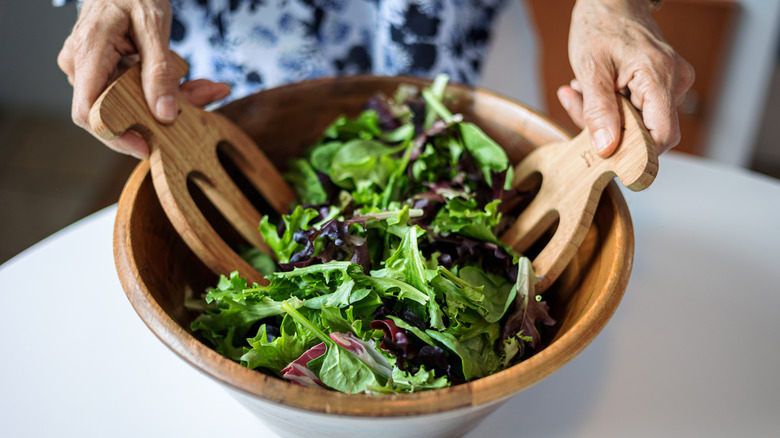Stop Making Boring Salads With This One Simple Fix
If your salad feels more mundane than delicious, the problem might not be that you're lacking a flavorful salad dressing recipe or that you need to add crunchy toppings; it might be the greens themselves. Starting with just one type of lettuce can leave your bowl tasting flat, no matter how many extras you pile on. The fix is as simple as it is effective: Mix your greens.
Different lettuces bring different things to the (salad) plate. Some are crisp and juicy, others tender and mild. Some leaves are peppery, others slightly bitter. Combining them creates contrast — not just in taste, but in texture and even how the dressing clings to each bite. And when done right, that contrast turns an average salad into something you actually look forward to eating. And before you scoff, we're not saying you have to be fancy with obscure greens or reinvent your grocery list. Just embrace variety, balance, and learn how to pair lettuces so they work together. A good mix can elevate even the simplest salad into a main-worthy dish without leaning too hard on cheese, croutons, or an overly generous pour of dressing (because salad should be healthy, after all). The lettuce is the foundation, and as the song says, "the house don't fall when the bones are good."
How to build the best base
The key to a great salad mix is pairing lettuces with complementary flavors and textures. Think of it like this: You want a foundation that's soft and neutral, a structural element for crunch, and something bold to keep your taste buds interested. A helpful rule of thumb is to use about half neutral greens (like Boston or Bibb), a quarter crisp or sturdy leaves (like romaine or iceberg), and a quarter with a kick (something peppery like arugula or radicchio) — there is a magic ratio to achieve when mixing salad greens.
The result is a mix that holds up well to toppings and doesn't wilt under dressing. Plus, it gives each bite a little surprise — maybe the bite of mustard greens, the sweetness of baby spinach, or the crunch of cabbage. Texture matters, too. Lighter greens help soak up dressing, while heavier ones give structure so your salad doesn't collapse under sliced chicken or roasted veggies. With the right blend, even a simple salad with oil and vinegar can taste layered and intentional. You don't need to overthink it, just start paying attention to how your greens interact, and switch things up when they don't. Because when the base is boring, the salad always will be. And who wants to yawn with lettuce in their mouth?

